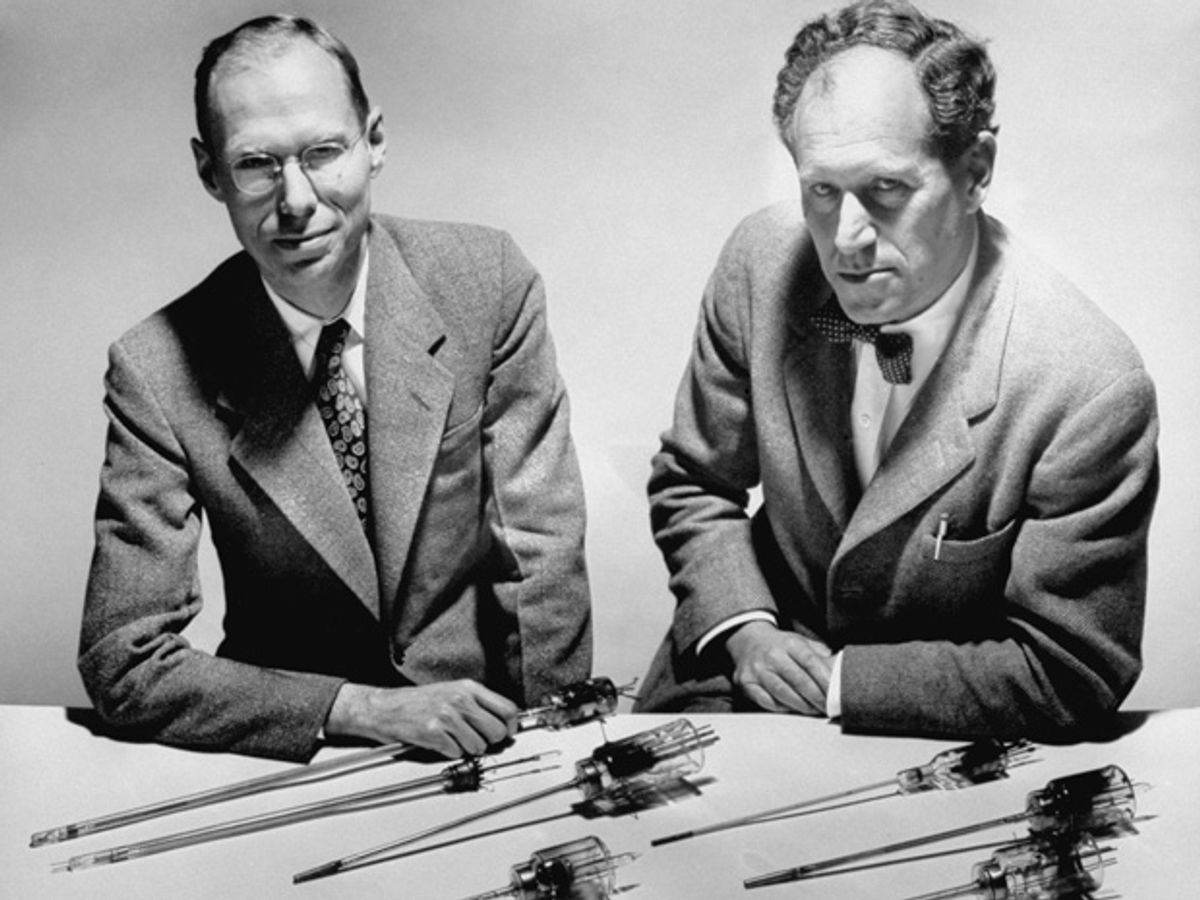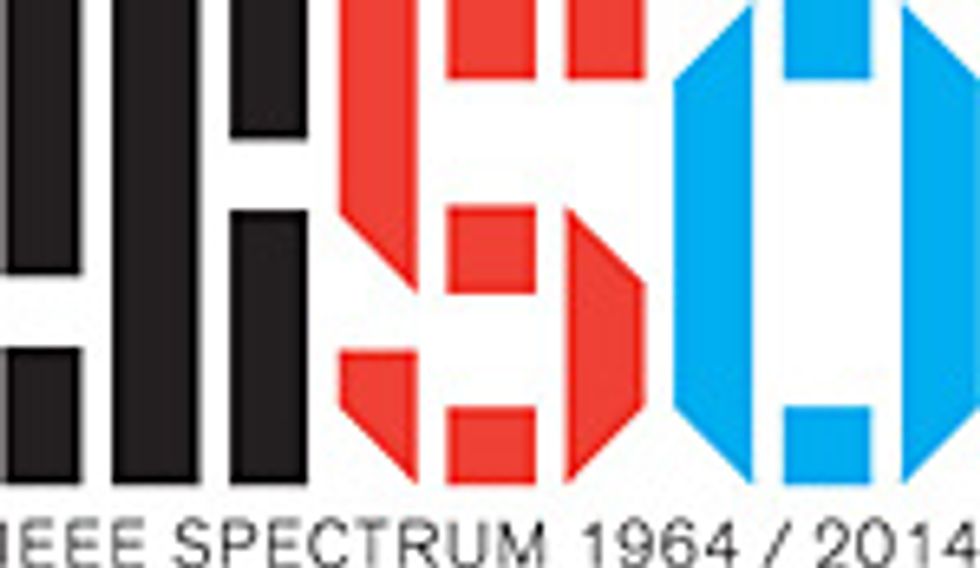A magazine, like a politician, needs friends. And the more powerful, the better. Throughout its first 50 years,IEEE Spectrum has benefited in no small measure from the support of the great, the famous, and the well-connected.
Sometimes they agreed to be interviewed about a sizzling topic of the day; sometimes they shared a personal recollection of a landmark breakthrough; sometimes they pulled strings behind the scenes for us. Every now and then they tipped us off to an upcoming event of seismic consequence. From time to time, they even wrote articles for us. Indeed, the roster of dazzling bylines in Spectrum is long.
Members of the trio associated with the establishment of Intel—Robert Noyce, Gordon Moore, and Andrew Grove—are listed as authors or coauthors on four different Spectrum articles. (Moore, however, contributed his most famous magazine article—the 1965 piece that introduced his eponymous law—to Electronics magazine, our archrival in those days.) William Shockley, one of the three inventors of the transistor and a former boss of Noyce and Moore, wrote a turgid feature we published in 1966 called “Articulated Science Teaching and Balanced Emphasis.” The article is interesting today mainly for a passage in which Shockley recalls a protracted argument, at age 15, with a science teacher concerning the best way to calculate the forces on a rowboat.
The other two inventors of the transistor, John Bardeen and Walter H. Brattain, never wrote for us. But Bardeen shared a touching anecdote with my colleague Karen Fitzgerald in 1988. He told her about the time he disclosed to his wife, in four words, the achievement of which he was part, which happened to be the greatest invention of the 20th century. As his wife prepared dinner one evening in 1947, their three children scampering around them, Bardeen said, “We discovered something today.”
“That’s nice, dear,” his wife replied.
In 1973 we published a feature article by Dr. Strangelove himself. Edward Teller, the man behind the hydrogen bomb, contributed an article with the clunky title “A Future ICE (Thermonuclear, That Is!).” Based on a conference talk, the story sketches out the basic physics of controlled thermonuclear fusion, for both power generation and space propulsion. In an odd but revealing sidebar, Teller renders this opinion: “I reject any expressions like ‘human engineering.’ These two words in this context don’t go together. Problems in engineering are solved by really different processes—often by logical processes. Whereas human problems are very often solved, and rightly solved, by illogical processes.” You read it here first, folks.
John R. Pierce, an early pioneer of pulse-code modulation and colleague of the trio at Bell Labs that invented the transistor, contributed no fewer than four feature articles to Spectrum. Pierce had one of the most brilliant and productive engineering careers of the 20th century. He improved on the traveling-wave tube, which had been invented in Britain during World War II by Rudolf Kompfner, who himself published a feature article in Spectrum in 1967 titled “Electron Devices in Science and Technology.” With writer Arthur C. Clarke, Pierce is credited with conceiving the communications satellite, and he later led the project that built the first commercial one, Telstar 1. What’s more, Pierce published science fiction novels and, at the end of his career, was a music professor at Stanford, where he discovered a new kind of musical scale.
Pierce was also known for his wit: “Funding artificial intelligence is real stupidity,” was one of many memorable quotes. An article he wrote for Spectrum elaborated on that very notion. “Many early computer enthusiasts thought that computers should resemble human beings and be good at exactly the tasks that human beings are good at,” he wrote. He likened that approach to “designing an airplane that will light on a tree. It is facing the future with one’s back squarely towards it.” Nowadays, with enthusiasm high for the technological singularity and its promise of machine consciousness, I long for Pierce’s authority, clear-eyed realism, and pungent humor.
Luminaries continue to appear in the pages of Spectrum. Best-selling author and Harvard Business School professor Clayton M. Christensen contributed to two memorable articles, one on the microprocessor business and the other on how the Toyota production method could be applied to semiconductor manufacturing. In 2008, not long after Hewlett-Packard researcher R. Stanley Williams and his team succeeded in building the long-hypothesized memristor, Williams described that work in a feature article for us. Nathan Myhrvold, a former chief technical officer of Microsoft and a cofounder of the huge patent holding company Intellectual Ventures, has contributed to two Spectrum features. The first, published in our June 2013 issue, described efforts to build a food compositor, which would assemble edible “elements” into delectable custom-made meals. His second article, published just last month, described why even costly modern ovens perform poorly and how they could be improved.
And then there was the article that got away. In 2006, a publicist for Microsoft Corp. sent us a manuscript and informed us that the byline could list as authors Bill Gates and one other Microsoft executive. However, when we showed the executive an edited version of the article, which was about a robotics initiative, the company balked and politely withdrew the draft. We next saw the piece in the pages of Scientific American, some months later. Predictably, it did not seem to have been substantially edited.
During my own career at Spectrum, I’ve been grateful many times for the help I received from the powerful or famous. I have interviewed U.S. senators, congressmen, and military generals; British diplomats; and government ministers in India and Iraq. I spent a blustery day sailing around San Francisco Bay and drinking ancient port with Silicon Graphics founder and Netscape cofounder Jim Clark, in his prebillionaire days. I had dinner with Jon Rubinstein around the time he was leading the design of the iPod, and I’ve spoken with Gordon Bell, best known for his pioneering work on minicomputers at Digital Equipment Corp., more times than I can remember. In Afghanistan, I interviewed the governor of Kandahar province in his palace, days after riots a few miles away killed 16 people.
At the fabled Washington, D.C., eatery Duke Ziebert’s, I ate alligator with an astronaut: Owen Garriott, who was trained as an electrical engineer and once held the record for the longest stay in space. Ben Rich, the legendary engineer who oversaw the design of the F-117A stealth fighter-bomber and helped design the U-2 spy plane, regaled me with dirty jokes during a freewheeling interview a year or so before he died.
The list goes on. I don’t have the space (and you don’t have the time) for an exhaustive acknowledgment of all the stellar and powerful friends who’ve supported Spectrum over the years, but I will pull a few more names out of the ether. Alfred N. Goldsmith, the radio pioneer and educator, and Bernard Oliver, who became R&D chief at Hewlett-Packard, helped us get off the ground in 1964. Jack Kilby and J. Fred Bucy, of Texas Instruments, were also reliable supporters in the 1960s and 1970s, as was Clarence Lester “Les” Hogan, another electronics-industry pioneer who combined engineering and executive brilliance. Michiyuki Uenohara, senior executive vice president of NEC, and Tsuneo Nakahara, vice chairman of Sumitomo Electric Industries, were our steadfast champions in East Asia; in a culture where personal connections are crucial, they introduced us to sources we otherwise had no way of reaching. Eberhardt Rechtin, CEO of the Aerospace Corp., Norman R. Augustine, CEO of Lockheed Martin, and Malcolm Currie, CEO of Hughes Aircraft, enabled us to bypass the bureaucracy and get aerospace and military stories we wouldn’t have gotten otherwise. Lewis Terman, who was a leader in IBM’s research establishment and the son of Frederick Terman, continues to advise us to this day.
All of these people went out of their way to help us when they surely had plenty of other claims on their attention. The only possible explanation for their generosity is that they believed in us and in our mission. They expected nothing in return. But, hopefully, this column is better than nothing.
This article originally appeared in print as “Famous Bylines in IEEE Spectrum.”

